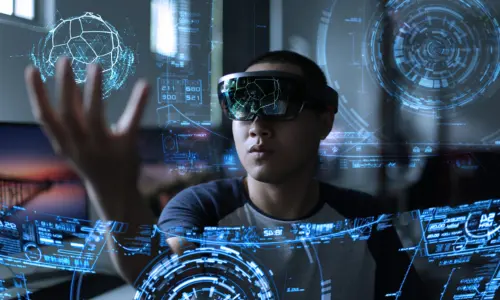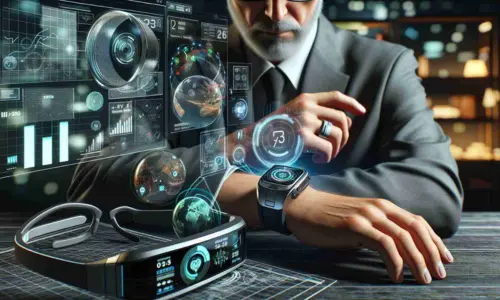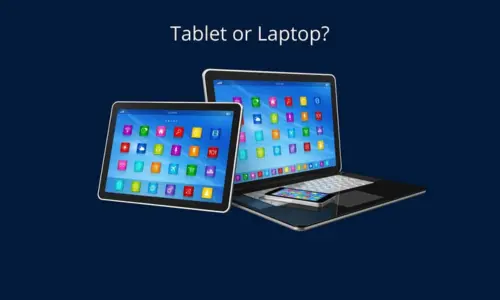Why Augmented Reality is the Future of Digital Interaction
Augmented Reality (AR) is not just a futuristic concept from science fiction—it’s a rapidly advancing technology that is redefining how we interact with the digital world. From gaming and education to retail and healthcare, AR is poised to revolutionize various sectors by blending digital elements with our physical reality.
In this article, we’ll explore why Augmented Reality is set to be the future of digital interaction, examining its current applications, the technology behind it, and its potential to transform everyday experiences.
1. Understanding Augmented Reality
1.1 What is Augmented Reality?
Unlike Virtual Reality (VR), which creates a fully immersive virtual environment, AR enhances the real world by adding digital elements that users can interact with in real time.
By using sensors, cameras, and advanced algorithms, AR systems can detect and interpret the user’s surroundings, allowing digital content to be accurately placed and interact with the real world.
1.2 Key Components of AR Technology
- Sensors and Cameras: AR devices use cameras and sensors to capture the user’s environment and track their movements. This data is essential for overlaying digital content accurately onto the real world.
- Processing Unit: The processing unit, often embedded in the AR device or connected to a cloud server, analyzes the data captured by the sensors and generates the appropriate digital content.
- Display: The display is where users view the augmented content. This can be through a screen (such as a smartphone or tablet) or through specialized AR glasses and headsets.
- Interaction and Feedback: AR systems often include mechanisms for users to interact with digital content, such as touchscreens, gesture controls, or voice commands.
2. Current Applications of Augmented Reality
2.1 Gaming and Entertainment
AR has made significant inroads in gaming and entertainment, with popular applications such as Pokémon GO demonstrating the technology’s potential to create immersive, interactive experiences. In Pokémon GO, players use their smartphones to see and capture virtual Pokémon in real-world locations. This type of AR gaming combines physical activity with digital engagement, offering a unique and engaging experience.
In addition to gaming, AR is being used in entertainment to create interactive experiences at concerts, theme parks, and live events. AR can enhance performances by adding visual effects, interactive elements, and additional layers of storytelling.
2.2 Retail and E-Commerce
In the retail sector, AR is transforming the shopping experience by allowing customers to visualize products in their own homes before making a purchase. For example, furniture retailers use AR to let customers see how a piece of furniture would look in their living room. Similarly, fashion retailers use AR to offer virtual try-ons, enabling customers to see how clothing and accessories will look on them without physically trying them on.
AR also enhances e-commerce by providing interactive product demonstrations, virtual showrooms, and personalized shopping experiences. By integrating AR into online shopping, retailers can bridge the gap between physical and digital retail, offering a more engaging and informative experience.
2.3 Education and Training
In education and training, AR offers innovative ways to enhance learning and skill development. For example, AR can create interactive textbooks that overlay additional information, animations, and simulations onto physical pages.
In professional training, AR is used to simulate real-world scenarios and provide hands-on practice without the risks associated with real-life training. For example, AR can be used in medical training to simulate surgical procedures or in manufacturing to provide step-by-step assembly instructions.
2.4 Healthcare and Medicine
AR is making significant strides in healthcare, offering tools for both medical professionals and patients. Surgeons can use AR to overlay critical information, such as patient anatomy or surgical guidelines, onto their field of view during procedures. This can improve precision and reduce the risk of errors.
AR is also being used for patient rehabilitation and therapy. For example, AR-based physical therapy programs can create interactive exercises and games that motivate patients to complete their rehabilitation tasks. Additionally, AR can assist with mental health treatments by providing immersive environments for exposure therapy and relaxation techniques.
3. The Technology Behind Augmented Reality
3.1 Computer Vision and Machine Learning
At the heart of AR technology is computer vision, which enables devices to interpret and understand visual information from the environment. Computer vision algorithms analyze images captured by cameras to detect objects, recognize patterns, and track movement.
Machine learning enhances AR systems by improving their ability to recognize and interact with objects in real time. For example, machine learning algorithms can be trained to identify specific landmarks, products, or gestures, enabling more accurate and responsive AR experiences.
3.2 Spatial Mapping and Localization
Spatial mapping allows AR systems to understand the physical layout of the environment and place digital content accurately within it. This involves creating a digital map of the surroundings, which is used to position and anchor virtual objects in the real world.
Localization refers to the process of determining the user’s position and orientation within the environment. This is essential for ensuring that digital content aligns correctly with physical objects and interacts seamlessly with the user’s movements.
3.3 Cloud Computing and Data Processing
AR experiences often rely on cloud computing to process and store data. Cloud-based AR platforms can offload complex computations and large datasets from local devices, enabling more powerful and scalable AR applications. This also allows for real-time updates and synchronization of AR content across multiple devices.
4. Challenges and Future Directions for AR
4.1 Technical Challenges
Despite its potential, AR technology faces several technical challenges that must be addressed to achieve widespread adoption. These include:
- Field of View: AR devices, especially wearables like smart glasses, currently have limited fields of view compared to the real world. Expanding the field of view while maintaining device comfort and performance is a key challenge.
- Battery Life: AR devices, particularly those with high processing power and display capabilities, require significant energy. Improving battery life is essential for ensuring that AR devices can be used comfortably and reliably.
- Privacy and Security: AR systems capture and process large amounts of visual and spatial data, raising concerns about privacy and data security. Ensuring that AR technologies are designed with robust privacy protections and data security measures is crucial.
4.2 Adoption and Integration
For AR to become a ubiquitous part of digital interaction, it must overcome barriers to adoption and integration. This includes:
- Cost: Many AR devices and applications are still expensive, limiting their accessibility to consumers and businesses. Reducing costs and making AR technology more affordable will be important for widespread adoption.
- User Experience: Ensuring that AR experiences are intuitive, comfortable, and engaging is essential for user acceptance. Developers must focus on creating seamless and user-friendly interactions to encourage widespread use.
- Content Creation: The success of AR depends on the availability of compelling and useful content. Encouraging developers and content creators to build AR experiences will be key to driving adoption and innovation.
5. The Future of Augmented Reality
5.1 Enhanced Personal and Social Experiences
As AR technology continues to evolve, it is expected to enhance personal and social experiences in new and exciting ways. For example, AR could enable virtual social interactions where users can meet and interact with friends in augmented environments, blending digital and physical experiences.
In entertainment, AR may create more immersive and interactive experiences, such as augmented concerts, virtual reality escapes, and interactive storytelling. The integration of AR with other emerging technologies, such as AI and IoT, will further expand its capabilities and applications.
5.2 Integration with Smart Cities and Infrastructure
AR has the potential to play a significant role in the development of smart cities and infrastructure. For example, AR could provide real-time information and navigation assistance for urban environments, such as guiding pedestrians through complex transit systems or offering augmented signage for public spaces.
In smart cities, AR can also enhance maintenance and management by overlaying digital information onto physical infrastructure, such as pipelines or electrical grids. This can improve efficiency and reduce the need for physical inspections.
5.3 Continued Innovation and Research
The future of AR will be shaped by ongoing research and innovation. Advancements in hardware, software, and algorithms will drive the development of more sophisticated and capable AR systems. As technology progresses, AR is likely to become more integrated into daily life, offering new ways to interact with and experience the world around us.
Conclusion
Augmented Reality is poised to be the future of digital interaction, offering transformative possibilities across a wide range of applications. From enhancing personal experiences and revolutionizing industries to reshaping how we interact with the world, AR is set to redefine our digital experiences.
As AR technology continues to advance, overcoming technical challenges and expanding its applications, it will become an integral part of our daily lives. By blending digital and physical realities, AR promises to create richer, more immersive experiences that enhance how we live, work, and play. The future is augmented, and the potential is boundless.







